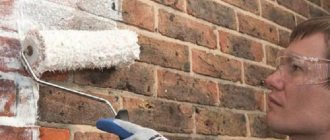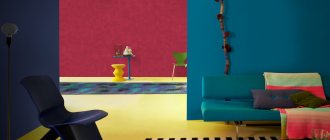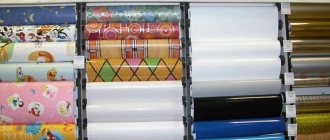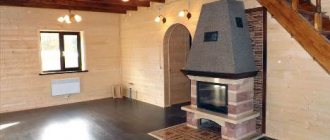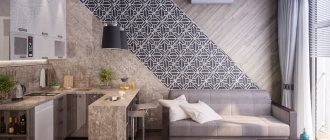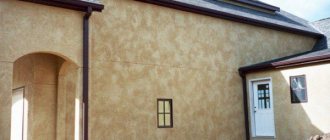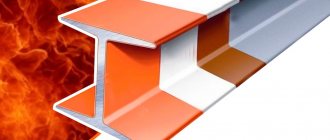Painting is the final stage of surface finishing work, during which the formation of texture and color is completed. There is a wide range of paint on the market, from which you can choose a material to solve any problem. Most people have no problems choosing a color. But even consultants in construction stores cannot always choose the right paint based on texture and performance and understand the variety of compositions. How to make the right choice and which glossy ceiling paint would be ideal?
Advantages of glossy paint
There are many advantages of a glossy surface. Benefits include:
- Moisture resistance. Glossy paint is an excellent option for the bathroom and kitchen;
- Easy to care for. The gloss withstands moisture and chemical exposure;
- Wear resistance. This characteristic allows you to frequently wash the ceiling surface.
These advantages allow you to create a beautiful, durable coating that is easy to care for. Also, with the help of glossy paint you can visually expand the space, which makes this type of coating indispensable in compact rooms. And spacious rooms with a glossy ceiling will look more impressive.
You can visually enlarge the room only if the glossy ceiling is in a light color scheme. But black, dark or bright colors visually reduce the size.
With the help of glossy paint you can visually expand the space, which makes this type of coating indispensable in compact rooms.
The best types of interior paint for home decoration: matte, semi-matte, glossy, semi-gloss
Spring is approaching, and with it comes a traditional holiday that is often forgotten - cleaning! A big part of annual cleaning is home decoration (or renovation). For the best result, it is not enough that the paint be interior; you need to pay attention to the type of paint or texture.
In this article we will explore the types of latex paint. Latex does not contain lead. Before the advent of lead-free or emulsion paints, lead poisoning was a serious hazard, especially for children and infants who might put paint particles into their mouths. Latex paint has a low odor, is non-toxic and is much safer to work with.
There are five main interior paint sheen levels for home decoration - matte, semi-matte, satin, semi-gloss and gloss or enamel. Each type of paint has a different look, feel, and how it performs. The biggest differences in paints are cost, mechanical strength and cleanability. Here's a rundown of paint types ranked from lowest to highest sheen. On the shelves of home improvement stores, paint will be displayed in this order and will increase in value depending on how much sheen it has.
Matte paint. Of the interior paint types, this is the least expensive and most matte paint. Use matte paint unless you never need to wash the surface. This paint shows all your fingerprints and does not resist grease or stains. Any fingerprint or smudge will penetrate the matte paint and smudge into unsightly spots. Matte paint can only be used on ceilings in bedrooms or hallways, not in kitchens or bathrooms. It has a nice matte finish, hides wall imperfections well and is the cheapest, but semi-matte or satin paint is recommended for general use.
Semi-matte paint. Semi-gloss paint is not as common for home trim, but is recommended over matte paint if you can find it. The cost difference is not that big, but the texture is different. As the English name of this paint (Eggshell) suggests, when it dries, the paint feels and looks like the surface of an egg. Semi-matte paint can be washed, but only with considerable effort. This paint is not the best choice for a kitchen or bathroom ceiling. Non-shiny paint is better suited for ceilings, as these surfaces look better matte, lacking a reflective effect. Semi-matte interior paints also hide wall imperfections.
Satin paints. For home trim, satin paint has all the texture and coverage benefits of semi-gloss paint, but is more affordable. Satin paint also cleans better, but is not suitable for any vigorous cleaning. Satin paint has the advantage of hiding brush marks better than semi-gloss or gloss paint. Satin paint is probably the best choice among all interior paint types.
Semi-gloss paint is the most expensive type of interior paint. Semi-gloss paint is generally most suitable for finishing a home in rooms that get the most use, such as children's bedrooms, playrooms, bathrooms, laundry rooms and kitchens. The semi-gloss paint has a nice shine and is very easy to clean. It is very durable and resists almost all types of dirt and grease very well. However, semi-gloss paint will show any imperfections in a wall, so don't use it on damaged walls.
Gloss paint is a very shiny paint that is harder to find. It looks very good in places such as bathrooms near the sink, toilet or shower and areas around the sink and stove in the kitchen.
There is also a sixth type of paint with some unique benefits called nursery paint. This type of paint is well suited for places where children play. Children's room paint can be washed with detergent, making it easy to clean. Coating prices vary, but you can expect to pay about $2 per gallon more for each gloss level. Then there is another type of paint that is available in most different types of interior paints and that is single coat paint. It costs more, but promises that one coat covers as much as two, covering even the most varied paint colors. One coat of paint is worth the extra money if it lives up to its promise. Even walls that are in very poor condition will usually be covered with one coat. Save money on different paint brands, sales and discounts, but don't try to save a few dollars by choosing the wrong type of paint for your use.
Flaws
Despite the undeniable advantages of this type of coating, it also has disadvantages. Thus, a pronounced gloss highlights all the defects and unevenness of the ceiling, so it is imperative to carefully prepare the surface before painting so that it is perfectly smooth. If such possibilities are not available, you can abandon the gloss in favor of a matte ceiling, which will hide all defects.
In addition, it should be taken into account that a glossy ceiling looks impressive only when the interior of the room matches the gloss. An interesting solution could be a combination of a glossy ceiling with the same walls.
The pronounced gloss highlights all the defects and unevenness of the ceiling, so it is imperative to carefully prepare the surface before painting so that it is perfectly smooth.
Important working points
It is better to start applying paint from the window, and then gradually move deeper into the room. To properly cover the ceiling, you may need from one to three layers, but in most cases two are sufficient. If you want to achieve a truly bright, effective and dazzling gloss, polish the surface after drying. This procedure can be carried out from time to time throughout the life of the coating.
Layers can be oriented in different ways during painting.
- You can place them crosswise - for example, if you applied the first along the room, then the second should be placed across. This option will allow you to get the most even coverage.
- The Finnish method provides that the paint is applied parallel to the window, that is, perpendicular to the direction of the rays.
- With the Swedish painting method, on the contrary, the composition is placed parallel to the rays of the sun that enter the room through the window.
Since a glossy paint composition reflects light well, it is worth paying attention to the issue of how to orient the layers, because this type of coating, unlike matte, actively interacts with the sun throughout its entire service life. This property must be used to the maximum to give the room the desired look.
Each new layer should be applied only after the previous one has completely dried.
Before applying the first layer of paint, do not forget to let the putty or other material that you used to level the ceiling dry thoroughly, and then thoroughly dry the previous one before applying each subsequent layer. Thanks to this, you can avoid the appearance of cracks, bubbles and other defects in the paint, which can greatly spoil the appearance of the surface. To the point where the paint will have to be removed and new applied.
Even if you have never used glossy paint to cover anything before and this is the first time you have thought about painting the ceiling with it, do not be afraid to choose this option. And if your ceilings are already smooth or you are willing to spend a little time and money to remove all the flaws, bringing the condition of their surface to ideal, then you can get an excellent result by putting gloss on them.
How to paint the ceiling in an apartment?
You will find the answer to the question in this article! You will also probably be interested in learning how to whitewash a ceiling using old whitewash.
Any room with such a ceiling will truly be transformed: it will sparkle and shine, it will begin to seem larger and more spacious. If it has a window, the sun will play on the glossy paint, filling the room with additional light. Due to the fact that the glossy paint coating is also durable, moisture-resistant, abrasion-resistant and easy to clean, it will be an excellent ceiling finishing option that can breathe new life into your interior and delight you, your family members and house guests for many years.
Video - How to perfectly paint a ceiling
| Water-based emulsion is a time-tested option for ceiling coverings. It is diluted with water, and you can choose the desired shade by mixing two or more different colors. |
| Acrylic, on the other hand, is a relatively new type of paint. However, he has already gained great popularity. The main advantages are the same as those of water-based emulsion. |
| Latex paint is non-toxic, durable and dries quickly. However, it is not very suitable for creating colors yourself, as it does not mix well. |
Types of glossy paint
Based on the type of thinner, paints and varnishes are divided into 2 categories:
- Organo-dispersive, based on organic solvents;
- Water-soluble or water-emulsion mixtures. Typically used indoors;
- By type of film-forming component - resin.
Glossy water-soluble paints are not common, and latex-based compositions do not exist.
Water-soluble or water-based mixtures are usually used indoors.
Water-based glossy ceiling paint
Glossy water-based ceiling paint has the following advantages:
- No unpleasant odors;
- Minimal toxicity;
- Dries quickly;
- With the help of tints you can give paint a variety of shades;
- Easy to apply;
- Easily removed from tools.
The disadvantages of water emulsion are:
- Permissible painting temperature is not less than +5°C;
- It is impossible to carry out wet cleaning, otherwise the coating will be washed off.
With the help of tints you can give paint a variety of shades.
Acrylic gloss paint
This paint and varnish product is the most common. Painting compositions based on acrylic resins have the same advantages as water-based ones; they are not subject to fading and can paint any substrate. In addition, acrylic paints and varnishes are inexpensive. At the same time, they are even more durable and moisture-resistant than water-based paints.
Acrylic paints are more durable and moisture resistant than water-based paints.
Organosoluble gloss paint and enamel
As a rule, coloring compositions of this type are rarely used due to their toxicity, pungent odor and fire hazard. These paints include:
- Oil-based paints and varnishes based on drying oil;
- Aerosols and alkyd enamels based on alkyd resins;
- Polyurethane enamels based on polyurethane resins.
The only advantage of organo-dispersion paints is the wide range of gloss shades.
The only advantage of organo-dispersion paints is the wide range of gloss shades.
Acrylic paint
Glossy acrylic paint has the following advantages:
- like water-based emulsion, the coloring composition can be used in rooms with high humidity and frequent temperature changes;
- long service life.
The main component of the coloring composition is acrylic resin, which makes application easy. During prolonged use, the surface painted with acrylic glossy paint does not fade.
How to choose ceiling paint
When deciding how to paint a glossy ceiling, it is important to remember that the decisive factor in this matter is the correct choice of paint and varnish. Thus, the first thing you should rely on is the coloring composition. But how to choose it correctly? When purchasing, you must consider the following nuances:
- The coloring mixture should be for indoor work. It is also worth choosing a specialized composition;
- No less important is the quality of the product, so the paint must comply with GOST.
Of course, many paints and varnishes can be tinted, but it is better to use a finished product in the desired color. You also need to take into account the amount of paint relative to the area of the base, taking into account such properties as hiding power. In general, the consumption of glossy paint and varnish for a ceiling surface measuring 10-12 m² will need 1 liter. paints.
Of course, many paints and varnishes can be tinted, but it is better to use a finished product in the desired color.
Existing types of ceiling paints
Popular manufacturers offer a large number of different types of paints. They are all great for decorating a room: glossy, matte, water-based and acrylic, any of them will give the room a neat and well-groomed look. Each type of paint has its own advantages and disadvantages, which must be taken into account when selecting material for finishing work.
Paint must be selected based on the type of ceiling covering
The following types of paints are used to paint the ceiling:
- acrylic;
- silicone;
- water-based;
- water-dispersed;
- latex.
The choice of these particular varieties is associated with a large number of their advantages. They do not emit an unpleasant pungent odor, adhere perfectly when applied and dry quickly. If necessary, such paints can be easily washed off or cleaned from the painted surface. It is imperative to take into account the characteristics of the room itself: high humidity, sunny side, etc.
Semi-gloss ceiling paints
Among paints and varnishes there are intermediate semi-gloss paints; their gloss is moderate. Such paints are moisture resistant, durable and not subject to abrasion. However, in semi-gloss paints the composition of all these properties is less pronounced than in gloss paints. However, unlike glossy ceilings, they do not focus so much on the defects of the base. Therefore, you cannot always count on an unambiguously good result.
Such paints are moisture resistant, durable and not subject to abrasion.
Reviews: the best paint for the ceiling
Semyon Arkadyevich Blentman, 69 years old, Moscow:
Good paint is always expensive. For a ceiling in a dacha, you can use oil paint; if you paint it wisely, and after drying you also apply varnish, it will be almost impossible to distinguish it from the same Tikkuril. Water-dispersed paint should be used to paint everything in the house; it does not crumble, does not remain on your hands, and does not harm you and your children. Everything else is natural chemistry; at best, paint the ceiling in the gazebo. If the paint gets dirty, it means a fake was slipped in; to erase the good material, you need to try hard. Although, if you rub too hard with a plastic brush, the paint layer can be damaged by scratches.
Mironov Vladislav Nikolaevich, Pushchino:
You need to take acrylate paints; you can’t get such whiteness in any other way, unless you buy titanium white. I painted it for three days in a row, I inhaled it, I thought it would be poisoning. It’s okay, I caught my breath, and that’s it, from alkyd you can end up in the hospital in a day. The quality is very good, the layer applies perfectly, you don’t need anything else to work in the house.
Recommended Posts
Design of a stretch ceiling in the kitchen
Finishing the ceiling with PVC panels
Decorative plaster on the ceiling: photo
Film for suspended ceilings
Attic ceiling: decoration and light
How to make a plasterboard ceiling
Hand-painted ceiling with glossy paint
Painting the ceiling surface with a glossy paint and varnish is carried out in five stages:
- First, the old paint is completely removed from the surface, but if the base is smooth, without peeling coating, then this is not necessary.
- Leveling the base. All defects must be eliminated.
- Applying a primer solution suitable for this paint. If painting is done on an old coating, then no primer is required; sanding and degreasing the surface is sufficient.
- Using a small brush, spread the paint and varnish along the edges of the ceiling.
- Cover with a roller or spray gun over the entire area to be painted.
Using a small brush, spread the paint and varnish along the edges of the ceiling.
Tips for choosing
We advise you to listen to the following recommendations when choosing paint:
- Give preference to water-soluble acrylic or latex compositions. They are easy to apply, dry quickly and do not have a strong odor;
- No matter how trivial it may sound, price is one of the indicators of paint quality. Do not try to save money, this can result in high costs, the need to apply several layers, poor quality of the coating and instability to cleaning;
- When buying domestic products, choose paint produced in accordance with GOST, not TU;
- If you need a certain shade, it is better to entrust the tinting process to special machines, which are available in all large stores. You will only need to choose a color from the catalog.
With automatic tinting you can get any shade
Preparatory work depending on the type of surface
Any painting must begin with preparing the base. Basic Rules:
- Household appliances, furniture and other things are removed from the room. Large items can be covered with film. The lamps are removable;
- Old paint is removed;
- The surface is primed.
Any painting must begin with preparing the base.
Drywall and gypsum fiber sheet (GKL and GVL)
Preparing the base from gypsum plasterboard and gypsum fiber board for coating:
- Using a spatula, use a spatula to treat the areas where the plasterboard is attached, so that the heads of the screws are covered.
- Dry cleaning.
- The corners are primed with acrylic solution.
- Prime the entire surface with a roller; after drying, apply the 2nd layer.
- After a day, the joints are covered with putty solution and sealed with reinforcing tape. Then the base is covered with a 2nd layer of putty on the seams. After drying, the seams are sanded with sandpaper.
- The drywall is completely puttied; after drying, the unevenness is eliminated with a spatula. The room is covered with film, a respirator is put on, and the ceiling is sanded with a construction trowel.
- Finishing putty. After drying, the ceiling is sanded again with a float.
- Dust is removed.
- The surface is primed for painting, and the ceiling dries within 24 hours.
The drywall is completely puttied; after drying, the unevenness is eliminated with a spatula.
Concrete ceilings
Preparatory work before painting the concrete base:
- The protrusions are removed with a hammer drill, and the cracks are widened using a knife.
- Irregularities are primed and sealed with mortar.
- The primer is applied, and after it dries, the procedure is repeated.
- Putty. After drying, the surface is sanded again with a float.
- Dust is removed.
- The surface is primed for painting, and the surface dries within 24 hours.
The surface is primed for painting, and the surface dries within 24 hours.
Wooden surface (plywood, chipboard, fiberboard)
Preparatory work for painting a wooden ceiling:
- The surface is cleaned with coarse grain.
- Treatment with antiseptic impregnation.
- Puttying cracks with a solution specially designed for wood.
- A new, flat ceiling is primed 2 times with drying oil. If there are defects, the wood must be puttied in several layers, with each layer carefully sanded.
- Next comes the primer for the paint.
Sheets of plywood, fibreboard and chipboard are prepared in the same way, only the primer solution is used specifically for chipboard, plywood and fibreboard.
If there are defects, the wood must be puttied in several layers.
How to paint a wooden ceiling
Wood is traditionally considered the most convenient material for painting:
- The porous surface of the wood absorbs the varnish base well;
- Wooden ceiling lining, as a rule, has a good surface quality, the paint layer is smooth and even.
But not all paints are equally suitable for wooden ceilings, even if the surface is primed or thermally hardened with a gas burner. In this case, under the influence of heat, water leaves and the lignin-cellulose base hardens. As a result, paint is consumed 1.5-2 times less than specified in the standard.
Painting the ceiling with oil paint
Good paint on a dry ceiling surface can last 15-20 years without peeling or blistering. Oil-based paints and varnishes do not have high decorative qualities, but of all paints they are the safest. They can be used in any room, except the kitchen. The part of the painted surface located above the stove very quickly darkens and becomes covered with bubbles.
Painting a wooden ceiling with alkyd paint
Enamels based on synthetic phthalic resins are used for painting floors and walls. You can also paint ceilings, but not in bedrooms and lounges. Alkyd paint can easily withstand washing and cleaning, but at the same time quickly wears down to a primer base.
In terms of decorative qualities, alkyd coatings are only slightly inferior to water-dispersed materials, while they are absolutely not afraid of water, which makes them a valuable means of protecting wooden floors.
Water-based paints are also available for wood
Water-dispersed ceiling paint
Acrylate dispersion can be used to paint a wooden ceiling only if the surface of the wood is first primed. In theory, you can paint without primer, but the quality and durability of such decor will be low. Water-dispersed coatings give ceilings a very expressive appearance, but they cannot protect against moisture.
Technology of applying glossy paint to the ceiling surface
When using glossy ceiling paint, it must be taken into account that all defects in the base will be clearly visible, so the work must be approached responsibly, following the instructions.
Work order:
- Good lighting is installed; if necessary, additional lamps can be used.
- The paint and varnish composition is prepared according to the manufacturer's instructions. More solvent is added to the first coating than to subsequent layers. Paint is poured into a special container in small portions.
- First, paint is applied in the corners and along the wall surface with a narrow brush.
- Then the entire surface is painted with a roller.
- The coloring composition is applied starting from the window with zigzag movements across the rays of light.
- Excess paint is removed with a clean roller.
- The next layer of paint is applied along the direction of sunlight.
The coloring composition is applied starting from the window with zigzag movements across the rays of light.
Which ceiling paint is best to buy?
All ceiling paints presented in our rating, regardless of the chosen category, have gained popularity among users due to their excellent qualities and characteristics. What is better to buy, acrylic or water-based, matte or glossy paint, is decided by the owner. It all depends on the type of room, level of illumination, ceiling design, and personal preferences of the buyer.
The best solution is PROFILUX PL-04 A universal white ceiling paint at an average price, made in Germany.
Features of painting the ceiling with different types of paints
The most popular is glossy water-based paint. However, many are interested in how to paint without leaving streaks. To do this, select a roller taking into account the following nuances:
- Handle size. The handle should be a telescopic handle or an extended one;
- Material. You need to use a fur roller;
- Density. A thick roller will be required;
- Seams. No rough seams;
- Pile. High-quality pile should not fall out.
The requirements for acrylic paint will be similar. For more even painting, you can use a spray gun.
For more even painting, you can use a spray gun.
How to work with gloss?
Preparing the surface for painting includes the following steps:
- removal of old coating;
- sanding with sandpaper;
- filling of gaps, cracks, joints;
- cleansing;
- primer.
The appearance of the future glossy coating depends on the quality of the preparatory work, so special care and leisure are required.
Glossy paint on the dining room wall
After this, paint is applied to a perfectly flat surface in one or two layers: with a brush in the corners, with a roller on large areas or with a spray on a small area or individual parts.
The enamel is applied to the primed surface in one layer.
Acrylic glossy bathroom paint
Thus, glossy paint can be considered an economical material: a liter of material is enough to paint about ten square meters.
Possible difficulties when applying glossy ceiling paint and options for solving them
When working with glossy paints and varnishes, a number of difficulties may arise that can be solved as follows:
- Thickened paint. It will help to avoid this situation by refusing to buy products on the street, where the mixtures freeze; you should also look at the shelf life of the product;
- Formation of stripes. This defect can be eliminated by moving the roller to the side, then the composition will be distributed evenly;
- Surges. It is necessary to reduce the amount of paint on the roller and move it over the base longer.
The frozen paint must be strained, a solvent must be poured into it, stirred well, after which it can be used.
It is necessary to reduce the amount of paint on the roller and move it over the base longer.
Of course, a glossy ceiling looks luxurious and can add a special chic to the room. However, before you start painting, it is important to properly prepare the surface, choose a paint based on the base material and follow the painting rules.
Problems when applying paint and how to solve them
When painting a ceiling, many things can go wrong as you planned. Let's look at a few common problems:
- Excessively thick paint.
To avoid getting too thick glossy paint, carefully read the instructions on the can, as this problem most often occurs due to a small amount of water in the paint.
- Stripes formed after applying paint to the ceiling.
In order to avoid getting streaks on the ceiling, firstly, roll out the roller in a W-shape, and secondly, as soon as the paint on the roller begins to run out, roll the roller along the painted ceiling. This will collect any remaining paint that is causing the streakiness.
- A layer of glossy paint that is uneven in thickness.
Next time, remember that you need to take a little more material onto a clean roller; in subsequent cases, you need to take less paint. This simple method will help avoid “sagging” caused by excess material.
Advice! For convenience, use a special trough in which you can dip the roller into the paint and also roll it along the “ribs” of the trough.
We hope that our tips will help you paint the ceiling correctly. After all, a ceiling painted with glossy paint not only looks beautiful, but is also a practical solution.
Glossy paint can create a rather original interior
